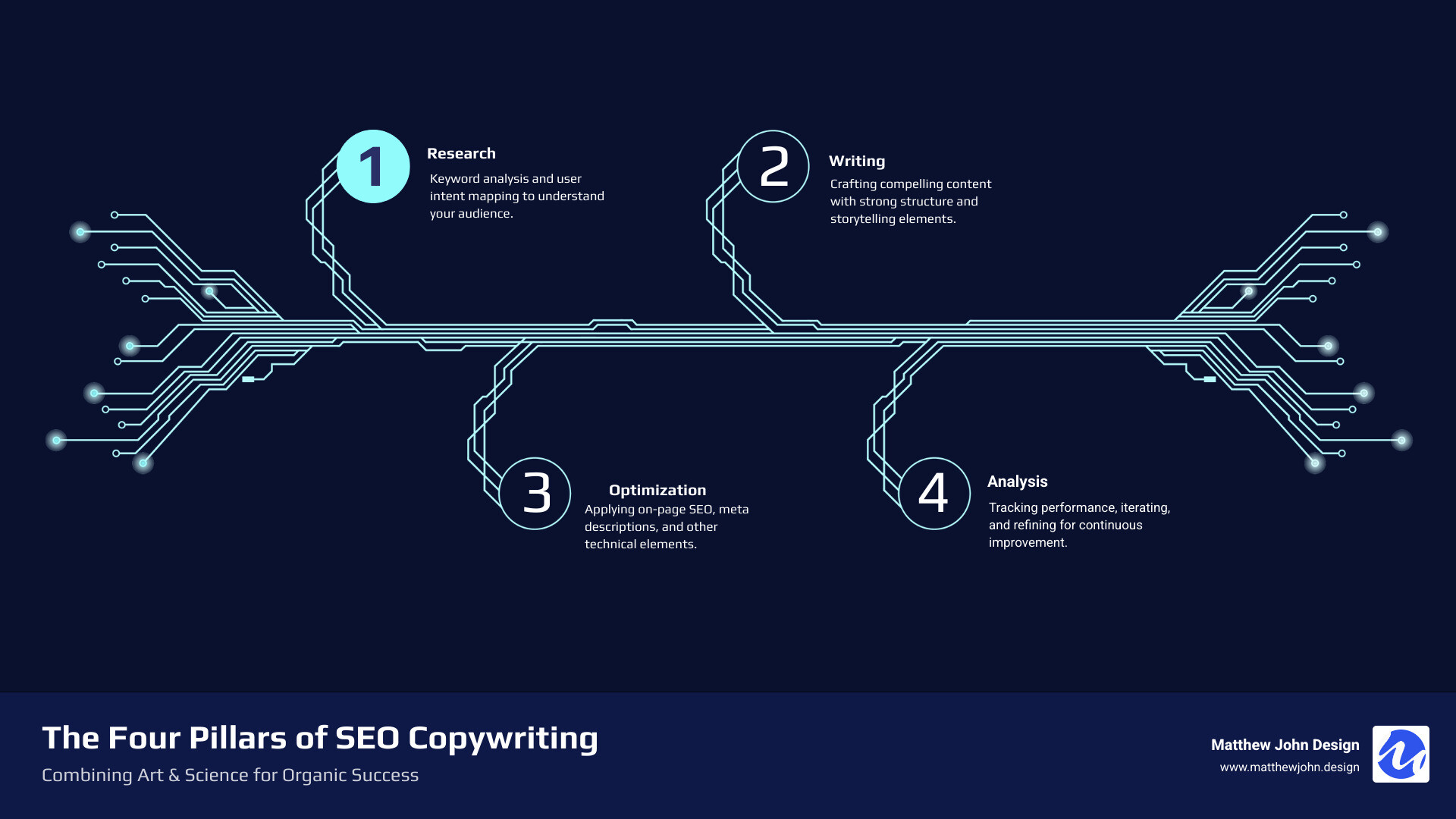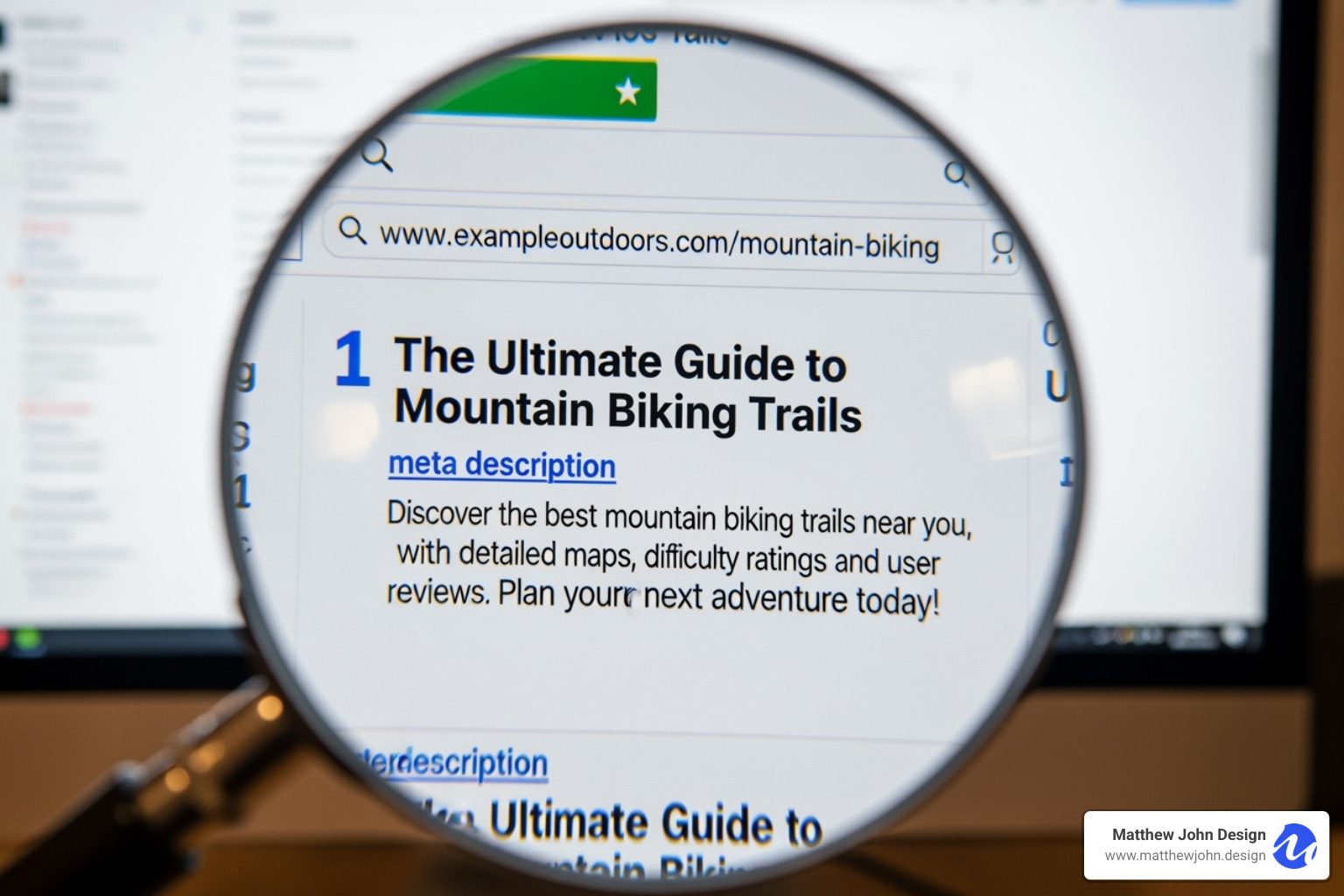Any information contained on this Website is not legal advice and should not be treated as such. You should always contact an attorney for help with your specific legal needs and issues. We may also earn a commission when you click links to our partners and purchase goods or services. For more information, read our Disclaimers Policy.
The Art and Science of SEO Copywriting in 2025
Search engine optimisation copywriting is the practice of creating content that ranks well in search engines while engaging real people. It blends keyword research, user intent, and compelling writing to drive organic traffic and conversions.
Quick Definition:
- SEO Copywriting = Writing that satisfies both search algorithms and human readers
- Key Elements = Keyword research + user intent + readability + E-E-A-T principles
- Goal = Higher rankings + better user engagement + increased conversions
With 53.3% of all website traffic coming from organic search, mastering SEO copywriting is essential for growth. Google's algorithms now prioritize people-first content, and the rise of AI means authentic, expert-driven copy stands out more than ever.
Copy vs. Content: Know the Difference
Copy sells. It's short, punchy, and drives action (e.g., product pages).
Content educates. It's longer-form material that builds trust (e.g., blog posts).
Both need SEO, but they serve different purposes. The challenge is that while AI can generate content quickly, it lacks the human insight for truly effective SEO copywriting. While 75% of content marketers plan to use AI in 2025, success still demands human expertise and an authentic voice.
This guide will show you how to master both the technical "science" of optimization and the creative "art" of human connection.

The Foundation: People-First Research and Keyword Strategy
Effective search engine optimisation copywriting begins with understanding your audience and what they're looking for. This "people-first" approach ensures your content genuinely helps.
To ensure your content is people-first, step into your audience's shoes. Use surveys, interviews, and monitor online conversations on platforms like Reddit or LinkedIn to understand their pain points and language. Complement this with SEO insights from tools like Google Trends to validate audience needs and identify search demand. This ensures you're writing what people are actively searching for.
Analyzing the Search Engine Results Pages (SERPs) for your target keywords reveals what content formats and topics are already ranking. Look at the top results and "People Also Ask" sections to identify content gaps and find "difference makers"—unique angles, personal stories, or proprietary data that will make your content superior.
Understanding and Matching Search Intent
Understanding why a user is searching is critical. There are four primary types of search intent:
- Informational: The user wants to learn something (e.g., "how to bake sourdough"). Create comprehensive guides or blog posts.
- Navigational: The user wants to find a specific site (e.g., "Matthew John Design services"). Your homepage or service page should be the target.
- Commercial Investigation: The user is comparing options before a purchase (e.g., "best Webflow SEO agency"). Offer comparison guides, reviews, or detailed service pages.
- Transactional: The user is ready to buy (e.g., "buy Webflow template"). Use clear sales copy and strong calls to action on product or checkout pages.
Aligning your content format and call-to-action (CTA) with user intent is paramount. An informational query needs educational content, not a hard sell.
Mastering Keyword Research for Effective SEO Copywriting
Effective search engine optimisation copywriting hinges on smart keyword selection and natural placement. Go beyond high-volume terms:
- Select the Right Keywords: Prioritize keywords relevant to your services that align with your target search intent. Don't forget long-tail keywords (e.g., "Webflow SEO settings best practices"), which often have lower competition and higher conversion rates.
- Use Related and LSI Keywords: Incorporate synonyms and related terms (Latent Semantic Indexing) to help Google understand your content's context and depth without keyword stuffing.
- Leverage "People Also Ask": This SERP feature is a goldmine for subheadings, FAQ sections, and ancillary keywords that deepen your content's relevance.
- Analyze Industry Leaders: See what your competitors rank for to understand the landscape and find opportunities to differentiate.
For an in-depth look, explore our guide on How Semantic SEO Impacts the Content Creation Process.
Using SERP Analysis to Inform Your Content Structure
SERP analysis helps you understand user expectations and what Google deems "best" for a query. By reviewing the top results, you can uncover key insights:
- Content Types: Are they blog posts, product pages, or videos? This tells you what format users prefer.
- Structure and Headings: How are the articles organized? Use their structure as a blueprint for your own.
- Depth of Coverage: What topics are covered? Are there unanswered questions you can address?
For instance, if top results for "Webflow SEO settings" are comprehensive guides, you know to create something similar in scope. If you spot a common question in the PAA section that isn't fully answered, that's your "difference maker." Structuring your content based on this analysis creates a logical flow that satisfies both users and search engines.
Crafting Compelling Copy: Structure, Storytelling, and E-E-A-T
Once you understand your audience, it's time to craft copy that connects. This is where search engine optimisation copywriting blends persuasive writing with a structure that both readers and Google love.

People-first content means putting yourself in your reader's shoes. They want answers fast, they want to feel understood, and they want to trust you. The best SEO copy feels effortless to read but is deliberate in its construction.
For more on creating content that serves users and search engines, see our guide on SEO Friendly Content Creation.
Structuring Content for Readability and Search Engines
Great structure guides both readers and search engine crawlers. Use a clear hierarchy:
- Headings: Use your primary keyword in your H1 (main headline). Use H2s for major sections and H3s for sub-points.
- Readability: Use short paragraphs (2-3 sentences), sentence variety, and bullet points or numbered lists to make content scannable and engaging.
- Internal Linking: Connect your content to related pages, like our What is SEO Content Creation guide, to add value and show search engines your expertise.
- Engagement Hooks: Use bucket brigades (e.g., "Here's the thing:") to keep readers scrolling. For introductions, the APP Method (Agree, Promise, Preview) hooks readers by acknowledging their problem, promising a solution, and previewing the content.
Integrating Storytelling and Human Connection
Stories make information memorable. Even in technical content, narratives connect with readers' challenges and goals.
- Brand Storytelling: Share the journey, values, and purpose behind your business to create an emotional connection.
- Customer Stories: Use generic examples to provide social proof. Instead of just data, frame it as a relatable success story.
- Conversational Tone: Write directly to "you" to make the content feel like a one-on-one conversation. Use a natural tone, skip jargon, and ask questions. As Copyblogger notes, the best copy feels genuine. A guide to good copy emphasizes this well.
Optimizing for E-E-A-T to Build Trust and Authority
Google's E-E-A-T principles (Experience, Expertise, Authoritativeness, Trustworthiness) are crucial for distinguishing your content from generic AI-generated articles.
- Experience: Show first-hand knowledge by mentioning specific projects or challenges you've solved.
- Expertise: Provide accurate, detailed insights that go beyond surface-level information.
- Authoritativeness: Build this over time with consistent, high-quality content and recognition from others in your field. Internal linking to pillar content helps establish your authority.
- Trustworthiness: Be transparent and accurate. Cite credible sources, keep information current, and include author bios to establish credentials.
Our deep expertise in areas like Webflow SEO: 5 Tips and our analysis of Is Webflow Good for SEO? directly support our E-E-A-T. Demonstrating qualifications and real-world experience builds confidence with both readers and search engines.
Advanced Search Engine Optimisation Copywriting Techniques
Beyond the fundamentals, sophisticated techniques can amplify the impact of your search engine optimisation copywriting. These strategies focus on capturing user attention and dominating search results.

Think of these as the difference between casting a wide net and precision fishing. While basic SEO gets you in the game, these strategies help you win it by owning the entire search experience for your target keywords.
Boosting Organic CTR with Titles and Meta Descriptions
Your title tag and meta description are your content's storefront window; they determine whether a user clicks.
- Compelling Headlines: Craft titles that are useful, urgent, unique, or ultra-specific. Instead of "Webflow SEO Tips," try "10 Proven Webflow SEO Strategies That Drive Results."
- Question-Based Titles: These tap into curiosity and have a 14% higher CTR. If someone searches a question, answer it in your title.
- Title Tag Modifiers: Add terms like "How to," "Best," "Guide," or the current year ("2025") to rank for long-tail keywords and signal freshness.
- Effective Meta Descriptions: While not always used by Google, a good meta description (around 160 characters) can boost CTR. Address the search intent, include benefits, and add a subtle call to action. Google's advice on snippets confirms that well-written descriptions can lead to more clicks.
Winning with Zero-Click Searches and Featured Snippets
Zero-click searches, where users find answers directly on the SERP, are becoming more common. You can win here by optimizing for featured snippets and AI Overviews.
- Optimizing for AI Overviews: Structure content with clear, concise answers in a logical format. This increases your chances of being cited by Google's AI. 52% of sources in AI Overviews already rank in the top 10.
- Creating "Snippet Bait": Deliberately format content to answer questions in ways Google loves to feature. Use clear definitions, numbered steps, and bulleted lists. Featured snippets have a high click-through rate (around 42.9%).
- Adding FAQ Sections: This is a great way to target secondary keywords and provide a buffet of snippet opportunities. Provide concise, direct answers to common questions.
Creating Your Own Keywords for a Branded Strategy
This advanced strategy involves creating your own branded keywords that you automatically dominate. It's about inventing a term for a unique methodology or framework that solves a real problem.
- Develop a Unique Concept: Identify a methodology that is uniquely yours, like a "Scalable Site Architecture" framework.
- Name Your Strategy: Choose a name that is memorable, descriptive, and searchable.
- Promote Your Term: Use it consistently across your content and communications to reinforce its existence and encourage people to search for it.
As your concept gains traction, others will reference and link to it, creating a powerful traffic source and a competitive "SEO moat" that is difficult to replicate.
The AI Revolution: Navigating the Future of Search
The emergence of artificial intelligence is fundamentally reshaping search engine optimisation copywriting. It's both a challenge and an immense opportunity.

AI has already changed how we create content. Think of it as a research assistant, not a replacement. It can help generate outlines, identify topics, and draft initial content. The magic happens when human insight meets AI efficiency.
How AI is Reshaping Search Engine Optimisation Copywriting
How has AI impacted SEO copywriting, and what are its limitations? While 75% of content marketers plan to use AI in 2025, it's important to understand its limits. AI excels at logical, data-driven tasks like creating outlines and drafts quickly. This frees up time for strategy and refinement.
However, AI struggles with the "right-brain magic" that brings words to life. It can't genuinely empathize with customers, share personal experiences, or offer truly unique insights. One study found AI chatbots provided incorrect answers to over 60% of queries, highlighting why AI isn't ready for unsupervised decisions.
In an age of abundant AI content, the value of original data has never been higher. Your proprietary research, customer interviews, and real-world case studies are precious differentiators that AI cannot replicate.
For practical guidance, explore our guide on AI Tools for SEO Content Creation.
SEO vs. Generative Engine Optimization (GEO): What's the Difference?
The rise of generative AI has introduced Generative Engine Optimization (GEO), also called AIO (AI Engine Optimization).
What are the key differences between SEO copywriting and GEO?
- Traditional SEO copywriting focuses on optimizing content for search engine links to drive clicks to a website.
- Generative Engine Optimization (GEO) focuses on optimizing content to be easily consumed and cited by generative AI models like ChatGPT or Google's AI Overviews. The goal is to be the authoritative source in a direct AI-powered answer, not necessarily to get a click.
This shift acknowledges that users increasingly expect immediate, conversational answers. For GEO success, provide concise, factual answers in your content (e.g., in FAQ sections), structure data clearly, and demonstrate high E-E-A-T credentials so AI models trust your information.
The future isn't about choosing between SEO and GEO—it's about mastering both. Human-centric content that demonstrates real expertise will always win, whether it's being read by a person or processed by an AI.
Frequently Asked Questions about SEO Copywriting
Search engine optimisation copywriting can be confusing. Here are clear answers to some of the most common questions we receive.
How long should an SEO article be?
There's no magic number. Comprehensive content consistently outperforms shallow content. Articles over 3,000 words often get more traffic, shares, and backlinks because they typically cover a topic more thoroughly.
However, length should always match search intent. A search for a simple definition requires a concise answer, while a search for a "complete guide" expects depth. Your goal isn't to hit a word count; it's to be the most helpful resource for that specific query. Write as much as you need to completely answer the user's question, and then stop.
How many keywords should I use in my copy?
Forget the old days of keyword stuffing. Modern keyword strategy is simple: focus on one main keyword for your primary topic. This should appear naturally in your title, URL, meta description, and introduction.
Beyond that, weave in several secondary and LSI keywords (synonyms and related terms) to add context. This helps Google understand your topic's relevance without sounding repetitive. The golden rule is to write for humans first. If the copy sounds forced, you've used too many keywords.
Can I use AI to write all my SEO copy?
AI is a powerful assistant, but it cannot replace human expertise. While 75% of marketers plan to use AI in 2025, it's best used for research, outlines, and first drafts.
AI falls short where it matters most: it can't share genuine personal experience, craft an authentic brand voice, or provide original insights. It struggles with the nuance and emotion that make copy compelling. Think of AI as an intern who handles the heavy lifting, but human editing is essential for quality, E-E-A-T compliance, and creating content that truly connects with people. This human touch is what will make your search engine optimisation copywriting stand out.
Conclusion: Your Next Step in Mastering SEO Copywriting
We've covered the core pillars of search engine optimisation copywriting: research, writing, optimization, and analysis. In 2025, success lies in its perfect blend of art and science—using data to inform content that connects with people through storytelling and an authentic voice.
The future is human-centric and AI-assisted. While AI tools offer efficiency, human expertise, real experience, and genuine understanding remain irreplaceable. Google's E-E-A-T principles are more important than ever in a world flooded with generic AI content. Anyone can generate words, but only a human can share a unique perspective, tell a compelling brand story, and build a memorable connection with your audience.
The brands that thrive will use AI as a powerful assistant while keeping humans firmly in control, creating content that doesn't just rank, but genuinely helps people.
Ready to put these strategies into action? At Matthew John Design, we specialize in search engine optimisation copywriting that drives real results. Our approach combines technical SEO with compelling storytelling to turn your website into a powerful lead-generating machine.
Explore our specialized SEO Writing and Video services and find how we can transform your content strategy for 2025 and beyond.

.jpg)